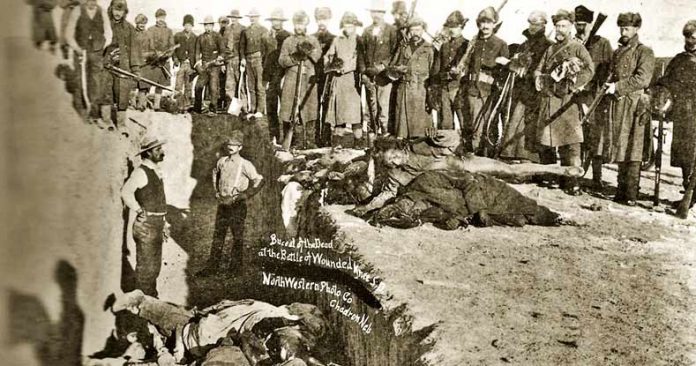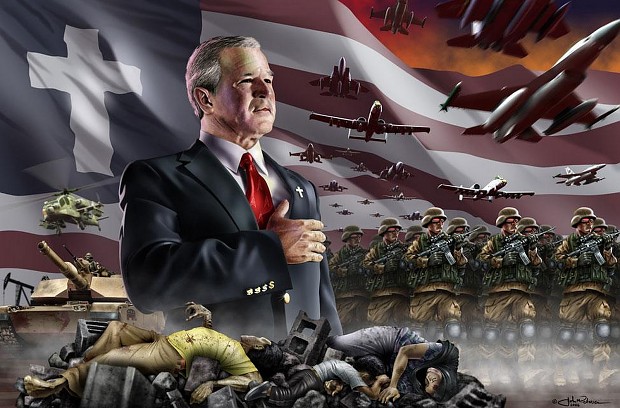As the death toll continued to rise from the Las Vegas shooting, media outlets were quick to call it "the deadliest shooting in U.S. History." However, that title was soon changed to "the deadliest shooting in modern U.S. History," as tales of past mass shootings on American soil were unearthed.
Here are three mass shootings in the United States with death tolls surpassing the Las Vegas shooting:
Sand Creek Massacre - Nov. 29, 1864
A horrific scene unfolded in Colorado in 1864, when a blood-thirsty army of U.S. Calvary members slaughtered over 500 peaceful Native Americans living in a village at Sand Creek. The Cheyenne and Arapahoe tribes were living on land that was rightfully theirs, as was acknowledged by a treaty with the U.S. government.
While Cheyenne Chief Black Kettle was known to be a peacemaker, Colonel John Chivington was looking for an easy military conquest, and he initiated the massacre by leading an army of 700 men on a night raid:
Governor Evans was intent on the "chastisement" of all the region's Indians and he had a willing cudgel in Chivington, who hoped further military glory would vault him into Congress. For months, his new regiment had seen no action and become mockingly known as the "Bloodless Third." Then, shortly before the unit's 100-day enlistment ran out, Chivington led about 700 men on a night ride to Sand Creek.The soldiers involved were initially praised for their murderous actions, but after the circumstances of the massacre came to light, Chivington resigned from the military. Chief Black Kettle miraculously survived the slaughter and continued his efforts to push for peace.
"At daylight this morning attacked Cheyenne village of 130 lodges, from 900 to 1,000 warriors strong," Chivington wrote his superior late on November 29. His men, he said, waged a furious battle against well-armed and entrenched foes, ending in a great victory: the deaths of several chiefs, "between 400 and 500 other Indians" and "almost an annihilation of the entire tribe."
Colfax Massacre - April 13, 1873
On Easter Sunday in 1873, racial tensions reached a breaking point in Colfax, Louisiana, and at least 150 African Americans were murdered after multiple white supremacist groups created a militia and attacked the Courthouse building.
In a county that was almost equally split by race, both the Republicans (mostly African Americans) and the Democrats (mostly white Americans) contested the results of the 1872 election, and refused to recognize either side's candidate as legitimate.
After the Republicans guarded the courthouse, the white militia arrived with a canon and took hundreds of the black soldiers as prisoners. The group, Know Louisiana described the gruesome circumstances surrounding the massacre:
"Late in the evening, white participants began to dispute the wisdom of releasing their black prisoners, as members of families drew close to the courthouse site. Led by the sons of James Hadnot, a group of militants proceeded to execute their captives. Members of the prisoners' families served as eyewitnesses to the killings, most of which were shots to the head."While the U.S. attorney in New Orleans attempted to prepare an indictment to hold the organizers accountable for their actions, federal Circuit Court and Supreme Court rulings threw out the convictions, and no one was ever held responsible for the Colfax Massacre.
Wounded Knee Massacre - Dec. 29, 1890
As many as 300 Native Americans were shot and killed in late 1890 - the majority of whom were women and children-after the United States Military's 7th Calvary Regiment surrounded a camp of the Lakota tribe along South Dakota's Wounded Knee Creek.
Soldiers moved in on the camp and demanded that the Native Americans surrender their weapons. While there are differing accounts of how gunfire broke out, the fact is that when U.S. troops started shooting, they did not stop, and they did not let the presence of innocent, unarmed women and children stand in their way.
One Sioux tribe member, named American Horse, recalled the horrific details of the massacre during a Commission of Indian Affairs in Washington, in February 1891:
"There was a woman with an infant in her arms who was killed as she almost touched the flag of truce, and the women and children of course were strewn all along the circular village until they were dispatched. Right near the flag of truce a mother was shot down with her infant; the child not knowing that its mother was dead was still nursing, and that especially was a very sad sight. The women as they were fleeing with their babes were killed together, shot right through, and the women who were very heavy with child were also killed. All the Indians fled in these three directions, and after most all of them had been killed a cry was made that all those who were not killed wounded should come forth and they would be safe. Little boys who were not wounded came out of their places of refuge, and as soon as they came in sight a number of soldiers surrounded them and butchered them there."Not only did the U.S. government not punish the soldiers responsible for the slaughter, the U.S. Army awarded 20 Medals of Honor to members of its 7th Calvary.
U.S. history textbooks tell the tale of the war between the power-hungry U.S. government and the indigenous tribes who sought to protect their land, but the Wounded Knee Massacre is especially significant because it serves as a reminder of how insignificant Native American lives were in the eyes of the United States.





Comment: And given the trajectory of the military-industrial-security-complex and apparatus currently in place, the worst, quite sadly, is probably yet to come.